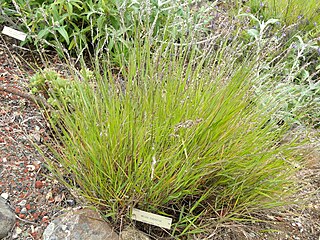
Melica picta is a species of grass in the family Poaceae that can be found in Europe, northwestern Africa and southwestern Asia.
Melica turczaninowiana, is a species of grass found in Mongolia, North Korea, Russia (Siberia), and China.
Melica subflava, is a species of grass that is endemic to China.
Melica tangutorum, is a species of grass found in China and Mongolia.

Melica teneriffae, is a grass species in the family Poaceae that is endemic to the Canary Islands.
Melica porteri, known as Porter's melicgrass, is a species of grass that grows in the United States and Mexico. In the US it is found in Arizona, Colorado, Kansas, New Mexico, Texas, Utah, and Iowa.
Melica scaberrima, is a species of grass that can be found in Yunnan, China, Nepal, Pakistan and northern part of India.
Melica onoei is a species of grass found in China, Japan, Korea, Pakistan and Taiwan.
Melica schafkatii, is a species of grass that can be found in Central Asia.
Melica eligulata is a species of grass in the family Poaceae. It is native to Afghanistan, Iran, Iraq, Lebanon, Syria, and Turkey.
Melica persica is a species of grass that can be found in Central Asia, India, and in Gansu, Jilin, Sichuan provinces of China.
Melica grandiflora is a species of grass that can be found in Japan, Korea and China.
Melica kozlovii is a species of grass found on mountain slopes in Mongolia and China at 2,000–3,900 metres (6,600–12,800 ft) above sea level.
Melica paulsenii is a species of grass endemic to Chile where it grows along the coastal cordillera at 50–700 metres (160–2,300 ft) above sea level.
Melica mollis is a species of grass endemic to Chile where it grows in rock crevices at 340 metres (1,120 ft) above sea level.
Melica minuta is a species of grass that can be found in North Africa, Western Asia, on Iberian Peninsula and in Southeast Europe.
Melica radula is a species of grass endemic to China. It grows on grassy mountain slopes and larch forests at 300–1,200 metres (980–3,940 ft) above sea level.

Melica penicillaris is a species of grass in the Poaceae family. It is endemic to Inner Anatolia, Turkey, where it grows on bushy hills, rocky slopes, limestone surfaces, and in gullies at 1,000–1,800 metres (3,300–5,900 ft) above sea level.
Melica rectiflora is a species of grass in the family Poaceae. It is native to Greece and Crete.
Melica longiligulata is a species of grass endemic to Sichuan province of China.



